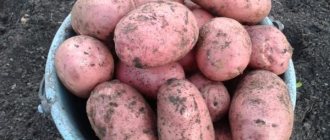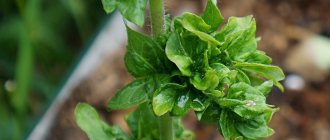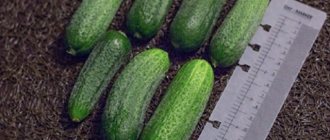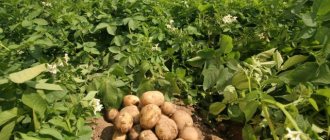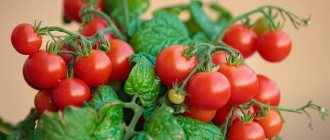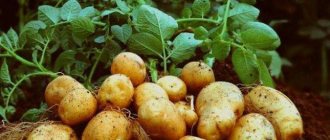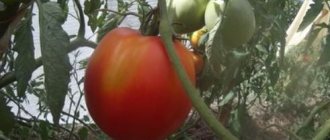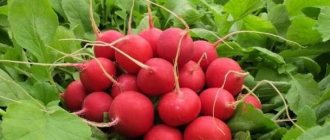Vegetable growing » Carrots
0
1041
Article rating
Kira Stoletova
Before growing vegetables or fruits, study the characteristics of the variety. NIIOH category 336 carrots were no exception. This is a high-yielding variety with medium ripening periods. Disease resistance is noted, which makes this species even more attractive.
Characteristics of carrots NIIOH
Advantages and disadvantages
The advantages of the variety include:
- high productivity;
- good keeping quality;
- adaptability to cultivation in almost all regions of Russia;
- versatility in application;
- increased carotene content (up to 23%).
The main disadvantage of this variety is its average immunity to most carrot diseases.
History of selection and main growing regions
The carrot variety NIIOH 336 received a strange name from the place of breeding work at the All-Russian Research Institute of Vegetable Farming. The selection is based on the parent varieties Vitaminnaya 6 and Hybrid 5, followed by individual selection of the best samples.
The variety was included in the State Register of the Russian Federation in 1978 and is accepted for gardening and commercial production in almost all regions, except for the northern regions, where the variety does not have time to ripen in the short summer.
Currently, carrots are grown everywhere, even in risky farming areas.
Detailed characteristics and description of the variety
- Appearance (shape and color of the root crop). Carrots grow in a cylindrical shape with a blunt end, weighing from 90 to 110 g. The length of the carrot reaches 20 cm, the diameter is up to 4-5 cm. The surface, pulp and core of the root vegetable are intense orange in color.
- Sowing time. For the NIIOH 336 variety, the average planting time is applicable - late spring, when stable warm weather has already established and when the danger of return frosts has passed.
In the central zone, this time falls on the third ten days of April; in Siberia, planting begins no earlier than May. In the Southern region, sowing dates traditionally begin earlier than everyone else - in the first and second ten days of March.But this variety can also be planted before winter, in late October - early November, when the air temperature has not yet dropped below 5°C.
- What is the yield from 1 hectare. The variety is productive - from 1 hectare you can harvest from 28 to 54 tons of carrots.
- Purpose of the variety and keeping quality. This variety has high taste and also contains an increased amount of carotene. According to its intended purpose, it is best suited for fresh consumption, as well as for canning. Keeping quality indicators are at the level of 82-92%.
- Growing regions. The variety is approved for cultivation throughout Russia with the exception of the Northern, Northwestern and Ural regions.
- Where is it recommended to grow? Carrots of this variety are recommended for growing in open ground.
- Disease resistance. The NIIOH 336 variety does not resist the most common carrot diseases very well. Pre-sowing seed preparation is an excellent prevention of many diseases, but it is not always enough.
- Maturing period. The variety is mid-season, since the growing season from the moment the first shoots appear is 110-120 days. However, in regions with a warm climate, ripening occurs much faster - in 80-90 days. Find out about other varieties of carrots based on their ripening time.
- What types of soil does he prefer? The variety prefers light, loose soils with low acidity.
Description of the variety
Niiokh 336 is a mid-season carrot variety. It is characterized by high yield and versatility in use: suitable for both canning and fresh consumption. It has good keeping quality and can be stored for a long time.
Origin and development
Breeders of the All-Russian Research Institute of Vegetable Growing obtained the variety by crossing Vitamin 6 and Hybrid 5 with subsequent selection. In 1978, Niioh 336 was included in the State Register of the Russian Federation.
The crop is recommended for cultivation throughout the Russian Federation.
Composition and properties
Carrots are rich in beta-carotene, contain a large amount of polyacetylenes, carotenoids (including alpha-carotene and lutein), hydroxycinnamic acids, which have antitumor and anti-inflammatory properties that form an adequate immune response of the body.
Vitamins in root vegetables:
- A (retinol) is found in the form of beta-carotene. Useful for maintaining healthy eyes, skin, growth and boosting immunity.
- H (biotin) promotes the absorption and processing of proteins in the body. Participates in metabolism in the skin.
- B6 (pyridoxine) is involved in growth, blood formation and circulation. Normalizes the functioning of the central nervous system.
- C strengthens the immune system and prevents the development of colds. Has an anti-stress effect.
- E (tocopherol) is involved in protein synthesis and metabolism. Supports the reproductive functions of the body.
- B1 (thiamine) is the most important vitamin for the nervous system. has a positive effect on neuro-reflex regulation.
- B2 (riboflavin) is actively involved in the redox reactions of the body.
Thanks to its high beta-carotene content (23%), carrots have antioxidant properties. Root vegetables reduce the risk of developing cardiovascular diseases and improve vision. Suitable for baby and diet food.
Reference. Vitamin A is a fat-soluble substance, so to absorb it, carrots are consumed along with foods high in fat.
Ripening time and yield
Carrot Niiokh 336 is mid-season - its growing season is 100–120 days. In warm regions, root crops ripen faster, in 80–90 days.
The productivity of the crop is high: 28–54 tons of root crops are harvested from 1 hectare.
Disease resistance
Niiokh is susceptible to the main types of diseases and pests of carrots: brown rot (fomosis), powdery mildew, aphids, mole crickets, carrot flies. Therefore, when planting carrots, the soil and seeds are treated, and preventive measures are taken during cultivation.
Characteristics
Carrot tops are dark green. straight, grows 40–50 cm in height.
The root vegetables are cylindrical with blunt ends, elongated: length - 20-30 cm, width - 4-5 cm. Average weight - 90-110 g. The color of the pulp is bright orange, the core is almost the same shade. The taste is excellent, with a characteristic carrot aroma.
Climatic conditions and growing regions
The Niiokh 336 variety is universal and suitable for cultivation in any region. Resistance to cold climates allows it to be grown even in the Irkutsk, Tomsk, Novosibirsk, Chita and Yakutsk regions. Carrots are drought-resistant.
Growing
- For carrots, it is important to choose open, well-lit areas. A few weeks before planting, it is recommended to add humus or compost to the soil (at the rate of 4 kg/m²). The seeds should also be prepared in advance - soak in a weak solution of manganese or use the preparation "Hom". This treatment will disinfect the seeds and also increase their immunity against diseases.
- Sowing is best done on a sunny day. First, grooves are made in the soil up to 1-2 cm deep. The distance between the seeds is left about 0.5 cm, then the soil is leveled and watered abundantly.
- Further care involves thinning - the first thinning should be done two weeks after sowing. The second thinning is after about three weeks. The distance between plants is left at least 5 cm. If thinning is not done, the carrots will begin to deform due to lack of space or grow too small.
- The variety needs sufficient watering - depending on weather conditions, you need to water the root crops once every 4-7 days. It is recommended to water carrots between the rows, and not under the bushes.
- Carrots respond well to fertilizers, therefore, during the season you can do three feedings:
- During periods of intensive growth, you can use superphosphate (50 g per 10 liters of water).
- At the time of flowering, potassium nitrate (30 g per 10 liters of water) is suitable.
- During the fruiting period, you can add ammonium nitrate (30 g per 10 liters of water).
Features of planting and growing
The Niiokh variety is demanding on lighting and soil quality. For a carrot bed, choose well-lit, not over-moistened areas and nutritious soil. The quality of the crop is influenced by previous crops, the frequency of watering and fertilizing.
Preparation
Taking into account the susceptibility of the variety to diseases, planting material is pre-disinfected in a weak solution of potassium permanganate or the preparation “HOM” for 24 hours.
Seeds sold in granule form have already been processed by the manufacturer.
Soil requirements
Heavy, rocky soil is not suitable for growing carrots, since in it the root crops will grow crooked and tasteless, and soil with high acidity. It is best to plant the vegetable in light sandy soil.
Before planting, humus, dry peat or compost (4 kg per 1 m2) are added to the soil.
Predecessors
To obtain a good harvest, take into account the rules of crop rotation. The best predecessors of carrots:
- tomatoes;
- onion;
- salad;
- potato;
- cucumbers
It is better not to plant root vegetables after dill and parsley: related crops will “reward” Niiokh with weak immunity with new diseases.
Landing dates and rules
The time for sowing carrots depends on the specific region. The optimal time is late spring, when there is no risk of cold snap and sudden frosts. For the middle zone this is the end of April, for Siberia and the Urals - the beginning or middle of May, and for the southern regions - the beginning or middle of March.
Attention! The variety is planted before winter, at the end of October, but at a temperature not lower than +5°C.
After the soil is ready, grooves 1-2 cm deep are made in it, into which the seeds are planted. About 0.5 cm is kept between them. The soil is leveled and thoroughly shed. The plantings are sprinkled with a small layer of peat or humus.
Features of cultivation
At the initial stage, it is difficult to grow carrots: after germination, the beds are regularly weeded, otherwise the weeds will quickly choke out the plantings. To prevent the formation of a crust that interferes with the growth of seedlings, the soil is carefully loosened. Water the crop as the top layer of soil dries.
Watering mode
It is better to water in the morning or evening so that the moisture is absorbed and not evaporated from the sun's rays. The frequency of watering depends on weather conditions. On average, the beds are irrigated once every 4–7 days. Excess liquid promotes the appearance of pests.
Attention! Water carrots between the rows, and not at the root.
Thinning and weed control
Carrots are thinned out 2 times during the entire growing season: 2 weeks after sowing and 3 weeks after the first time. This is done very carefully, since when the root is touched, the carrot produces a new shoot at the site of the break, as a result of which it grows horned and crooked.
Top dressing
Without feeding carrots, it will not be possible to obtain the desired harvest, so nitrogen or potassium fertilizers are applied during the period of active growth.
During the entire growing season, plantings are fed 3 times:
- during the period of growth and development of seedlings, superphosphate is added (5 g per 1 liter of water);
- at the flowering stage, potassium nitrate is used (3 g per 1 liter of water);
- When fruiting, ammonium nitrate is used (3 g per 1 liter of water).
Organics are not used as fertilizer, because carrots do not tolerate fresh manure.
Disease and pest control
Despite the preventive measures taken, diseases appear with improper care:
- When affected by brown rot, gray-brown spots form on the stems, and voids appear in the root crops. For treatment, a solution of colloidal salt is used.
- The Regent fungicide is suitable for powdery mildew, the sign of which is a gray-white coating on the tops.
Main pests:
- Aphids are small insects that accumulate on the stems and petioles of carrots. Oxychom is used against them.
- Carrot flies . When they appear, the leaves begin to turn yellow and dry out for no apparent reason, and the roots rot. Insecticides “Aktellik” and “Aktara” are effective in pest control.
- Medvedki. Signs of appearance are similar to previous pests. Bordeaux mixture and eggshells spread between the rows help a lot.
Difficulties in growing
The main problems when cultivating the variety:
- Yellowing and weakening of seedlings. A possible reason is the presence of pests. In this case, the plantings are treated with Aktara or Ecogel.
- The carrots are cracking. Often the problem is caused by excess moisture.
- Crooked root vegetables. Carrots are deformed in heavy rocky soil, so river sand, sawdust or other leavening agent are added to such soil. Other reasons are improper watering and fertilizing regimes.
- Vegetables grow small. This is facilitated by insufficient moisture, lack of light or untimely thinning.
Harvest and storage
Like other varieties, NIIOH 336 must be collected before frost. In addition to calculating the date for harvest based on the ripening time of a given variety, you can also focus on the yellowing of the lower leaves.
As soon as the soil on the pulled out root crops has dried, the tops should be removed.
Before storing, carrots are sorted out and damaged or diseased roots are set aside. To increase the shelf life of the crop and protect it from diseases, you can dust the carrots with chalk powder. The method of sprinkling carrots with pre-calcined wet sand or pine sawdust is also practiced.
Diseases and pests
This variety has average immunity to most diseases, so it is important not only to carry out preventive preparation of seeds for planting, but also to know how to combat diseases:
- Treatment with Fofatox solution will help against late blight.
- For root rot - a solution of colloidal salt.
- For powdery mildew, the drug “Regent” is suitable.
Parasites can also often become a headache for gardeners growing this variety.
- To combat aphids, you can use the drug "Oxychom".
- The drug "LuxBor" will help against midges.
- A solution of wood ash can be used against the Colorado potato beetle.
- From the mole cricket - Bordeaux mixture.
Various problems during cultivation and ways to solve them
Failure to comply with the rules of agricultural technology, unfavorable weather conditions, poor-quality seed material and other factors can lead to certain problems when growing carrots.
Knowing how to solve these problems, with timely actions you can save the future harvest or avoid repeating the same mistakes and problems next season:
- The shoots or tops turn yellow, stretch out and weaken - if the cause is parasites, then the drugs “Aktara”, “Ecogel”, “Zircon” are used to combat them.
In case of disease with phomosis (seedlings begin to turn yellow from below), brown spot (seedlings first turn yellow at the edges and then turn brown) or rhizoctonia, the plants will have to be destroyed, since with further storage they can infect the rest of the crop. - White core inside - the cause may be poor-quality seed material, as well as an excess of nitrogen against a background of deficiency. In the second case, adjusting the fertilizer application schedule will help solve this problem.
- Root crops crack - this happens due to uneven watering, excess fertilizer, heavy soil, and overripening of an early variety.
It is important to monitor the uniformity of watering and apply fertilizers correctly (especially be careful with nitrogenous ones). If the site has heavy clay soil, you should give preference to varieties with short roots or plant carrots in raised beds. - Carrots grow unsweetened and dry - this may be due to the characteristics of a particular variety, as well as a lack of watering or fertilizer.
- Deformed root crops - the reasons for this phenomenon may be poor soil preparation (many stones), lack of watering in the first month after planting, incorrectly selected fertilizers (you cannot use manure, potassium chloride and potassium salt) and pest invasion.
- Carrots grow very small - this may be due to the characteristics of a certain variety, lack of sun, or, conversely, excessive heat. In the latter case, it is worth increasing the volume of watering.
Perhaps the soil on the site is unsuitable - too heavy or too acidic. Adding sand at the stage of preparing the soil for planting, as well as lime or dolomite flour, will help correct this situation next season.
Features and characteristics
The variety is mid-season - the growing season from sowing to technical ripeness is 110–120 days. In the southern regions, ripening is faster and takes 90–100 days. Root crops are uniform in size and of good quality. Carrot tops form an erect rosette up to 50–60 cm high.
Keeping quality is average. The harvest is stored for up to 4–6 months, the marketability of products during storage is 80–90%. The purpose of the variety is universal: “for a bunch” at early stages, fresh, for preservation and making juices.
Description of root vegetables
The root crop has the following characteristics:
- average size - by the time of ripening it reaches a weight of up to 130 g and about 18 cm in length;
- cylindrical shape, with a blunt end and the same diameter (5 cm) along the entire length;
- the surface is smooth, the color is bright orange;
- the core is round, one third of the diameter, red-orange;
- the consistency of the pulp is juicy, crispy, the taste is sweet;
- high carotene content (19 mg/100 g of product);
- immersion in the soil is complete.
Ripening time and yield
The variety is mid-season - ripens in 100–120 days. Sowing is carried out in April-May, harvesting - in July-August.
Productivity is 6–9 kg/1 m² or 1000 c/ha in commercial production
Variety immunity
The variety is cold-resistant, moderately resistant to diseases, and is not susceptible to bolting or flowering. Zoned for areas with unfavorable weather conditions and risky farming areas.
Similar types of carrots
The following varieties of carrots are the closest in taste, ripening time, yield and keeping quality, as well as in appearance:
- Altair F1.
- Losinoostrovskaya 13.
- Incomparable.
- Forto F1.
The NIIOH 336 variety is widespread due to its adaptability to cultivation in almost all regions of Russia. The lack of specific features of crop care, high yield and keeping quality of this variety make it attractive for growing in garden plots.
However, not very high immunity against most common diseases makes it necessary to preventively prepare seeds before planting and further close monitoring of the condition of the plants.
Is it easy to grow carrots? What kind of crop can be harvested? What planting advice do experts give? You will find answers to all these questions, as well as all the rules for growing, in separate materials on our portal. Read about the following carrot varieties: Baltimore, Samson, Sentyabrina, Karotel, Imperator, Touchon, Moscow Winter, Chantane, Laguna and Canada.
general characteristics
Carrots of the NIIOH variety category 336 are ideal for growing in the Central and Northern regions of the country. Planting is often carried out in the southern regions, where the ripening time of the plant is much lower.
According to the description, the growing season is 110-120 days from the moment of formation of the first shoots. In the southern parts, the growing season lasts only 80-90 days. The variety belongs to hybrid crops. It was obtained after combining the Vitamin variety and a hybrid of the 5th category.
Carrots of the NIIOH variety are ideal for universal use: they are used for preparing winter preserves and consumed fresh. Due to the high concentration of carotene in the composition, it has a positive effect on human vision. High storage rates are noted.
Appearance
The leaves are characterized by an erect rosette up to 50 cm in height.
The lower part of the bush (root crop) sinks deep into the ground. If cultivation is carried out on light soils, then harvesting is carried out quickly, without loss of high-quality fruits.
The average length of the fruit is about 20 cm. The diameter is 4-5 cm. The fruits weigh about 110 g.
